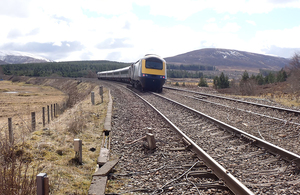Derailment at Dalwhinnie
Investigation into a derailment as a result of a signalling system fault at Dalwhinnie, Scottish Highlands, 10 April 2021.

The derailed power car at the rear of the train
At around 03:03 hrs on 10 April 2021, an empty high speed train (HST), being used to check platform-train stepping distances, was wrongly diverted from the up line to the down line at a crossover located around 190 metres south of Dalwhinnie station. Before the train was able to be stopped, its rear three bogies became derailed due to the points at the north end of the crossover moving under the rear of the train.
The crossover comprised a set of points at each end of a short section of track linking the up and down lines. The maximum permitted speed is 70 mph (113 km/h) on the up line and 15 mph (24 km/h) when traversing the crossover. The train was travelling at around 33 mph (53 km/h) when it was wrongly diverted onto the crossover and came to a stop around 290 metres beyond it. There were five people on the train including the driver; no one was injured. The derailed portion of the train, track and signalling equipment were damaged.
The signal on the approach to the crossover was displaying a proceed indication for the route along the up line and there is no signalled route from there, over the crossover, to the down line. Both sets of points forming the crossover were detected as being in the correct position for the up-line route by the signalling system and were indicated as such to the signaller, even though the points at the north end of the crossover (the end nearest Dalwhinnie station) were set in a position to divert the train onto the crossover.
Our investigation will seek to identify the sequence of events which led to the accident. It will also consider:
- Why the signalling system did not detect that the points were in an incorrect position thereby allowing the signal to be cleared for the movement along the up line
- How the points were able to move as the train passed over
- Factors associated with the installation, testing and maintenance of the point machines that operated the crossover
- Any relevant underlying factors, including the rail industry response to RAIB’s recommendations made its Greenhill Upper Junction (Report 04/2010) and Waterloo (Report 19/2018) investigations.
The investigation report is currently in formal consultation with industry, and it is expected to be published in September.
Our investigation is independent of any investigation by the railway industry or by the industry’s regulator, the Office of Rail and Road.
We will publish our findings, including any recommendations to improve safety, at the conclusion of our investigation. This report will be available on our website.
You can subscribe to automated emails notifying you when we publish our reports.